
Cisco Jabber
Collaborate Anywhere on Any Device with Cisco Jabber
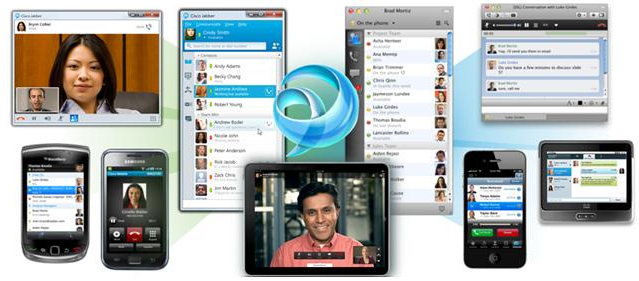
Sorry, this product is no longer available, please contact us for a replacement.
Overview:
Cisco is a global, collaborative enterprise, and video is an important collaboration tool for Cisco teams that work together from around the world. Cisco IT supports a "video everywhere" policy, meaning all Cisco employees should have access to video tools that enable them to see and talk with each other from any location. The Cisco Jabber clients offer the newest video-based collaboration tool for Cisco employees.
Cisco Jabber is a family of software clients that allows a user to easily access capabilities for voice and video calls, provides a contact directory with presence information for colleagues, and includes tools for instant messaging (IM), voice messaging, desktop sharing, and conferencing.
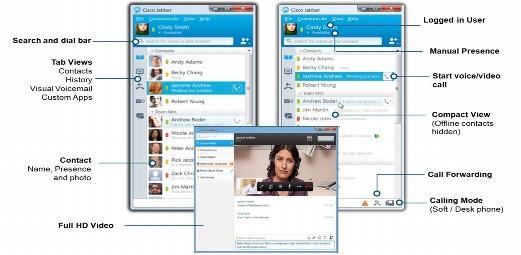
Cisco Jabber Features and User Interface
Today Cisco IT supports multiple Jabber clients for use by employees, including clients for Microsoft Windows-based and Apple Macintosh computers, Apple iPhones and Android-based smartphones, and Apple iPad tablets.
"To me, Jabber is a core presentation technology that bridges the old world of hardware-based communications to the new world of cloud, social, mobile, and software-based communications," says Koen Denecker, Cisco IT infrastructure architecture director.
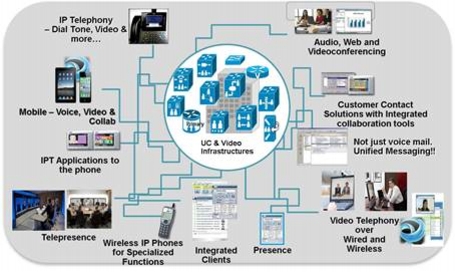
Cisco Network and Platform Services Used by Jabber Clients
Features and Benefits:
Easily access voice, video, presence, instant messaging, voice messaging, desktop sharing, and conferencing capabilities.
Instantly Interact with IM and Presence
Reduce delays with real-time presence information and instant messaging. View users' availability and chat with individuals or groups, within and outside your organization.
Enjoy Business-Class IP Voice and Video Telephony
Cisco Jabber is a soft phone with HD video and desktop sharing capabilities. Powered by Cisco Unified Communications Manager call-control, it delivers secure, reliable communications.
Get a complete collaboration experience for your iPad
Be more productive from any location with Cisco Jabber on your iPad. Access presence, instant messaging (IM), voice, video, voice messaging, and conferencing, from anywhere. Join telepresence meetings when you are away from the office.
Communicate From Microsoft Office
Cisco Jabber is integrated with Microsoft Office. See a user's availability and click to initiate communications such as chat, voice or video calls, or multiparty conferences.
Get Mobile Collaboration-Anywhere on Any Device
Communicate across campus, at a customer site, or anywhere with mobile voice, video, IM, and web conferencing. Use your preferred device and get the same experience as at your desktop.
Communicate from Within Web Applications
The Jabber Software Development Kit (SDK) lets you experience rich communications, including HD video, from within web-based business. Simplify workflows and increase productivity.
Solutions:
Challenge
Cisco IT decided that the Jabber clients would be available to all Cisco employees as part of their basic communication services along with:
- A telephone number, a voice mailbox, and a laptop
- Access to Cisco TelePresence room-based videoconferencing tools
- Access to collaboration tools such as Cisco WebEx Social and cloud-based tools such as Cisco WebEx Meeting Center
The decision to support Jabber clients for all employees, which meant adding more than 70,000 mobile video endpoints onto the Cisco network, caused some initial concern. Fixed endpoints such as Cisco TelePresence rooms can be planned in advance to help ensure that network access bandwidth is adequate at any building or campus. In contrast, Jabber clients on laptops can move from building to building, sometimes in unpredictable ways. However, Cisco employees were already using mobile video clients, including Cisco IP Communicator and the cloud-based Cisco WebEx Meeting Center, so Cisco IT was well-prepared for the impact of mobile video on the network.
Another issue arose because Cisco has a bring-your-own-device (BYOD) program that allows many employees to use approved mobile devices in their work. Cisco IT needed to accommodate the potential that every employee might download multiple Jabber clients for their multiple devices. For example, employees might use Jabber for Windows or Jabber for Macintosh on their laptop computers as well as separate Jabber clients on a smartphone and tablet, which would require more resources from the current Cisco Unified Communications Manager (UCM) clusters.
Cisco IT also needed a way to calculate and verify that sufficient bandwidth would be available in the network, especially in local nodes, to handle the higher traffic volumes and performance demands of video calls.
Solution
Before offering Jabber clients to employees, Cisco IT verified network services and created automated tools to provision the clients for individual users on the Cisco UCM system. The team also created separate programs for deployment, support, and ongoing management for each supported Jabber client.
Network Considerations
Each Jabber client used by an employee is configured as a separate device on the Cisco UCM system, meaning a single employee could have multiple UC devices configured, such as for a desk phone and Jabber clients on the employee's laptop and smartphone. Cisco IT had previously upgraded its Cisco UCM clusters to version 8.6.2, which allows for a capacity of more than 10,000 devices per subscriber server.
Cisco IT expects all of its 70,000 employees worldwide will use one or more Jabber clients, but that the number of video endpoints will not grow significantly. "Most of our employees already have a soft client, either Cisco WebEx Connect, Cisco IP Communicator, or Cisco Unified Personal Communicator. For them, Jabber is a replacement," says Jon Heaton, unified communications architecture manager at Cisco IT. "But we also expect to provision many thousands of new clients, so we have proactively configured our Cisco UCM clusters to support a larger number of subscriber devices. Still, we will need to monitor and manage the device capacity on the call clusters to make sure the devices are being actively used."
Network QoS
The Cisco network was already designed to support the demands of multiple access devices and clients. However, the bandwidth demand of Jabber video calls on the DS3 and OC-3 circuits in local offices was a concern.
The quality of service (QoS) definitions are illustrated in Figure 1. Because of the high expectations for video quality, the largest amount of circuit bandwidth in a local office is allocated to the video queue. Within that queue, priorities are set for handling traffic from the different endpoint types, (e.g., Cisco TelePresence and Cisco Jabber) based on user expectations for video quality in those sessions. During periods of network congestion, the quality (resolution) will decline first for Jabber clients and personal endpoints and last for an immersive, room-based TelePresence session.
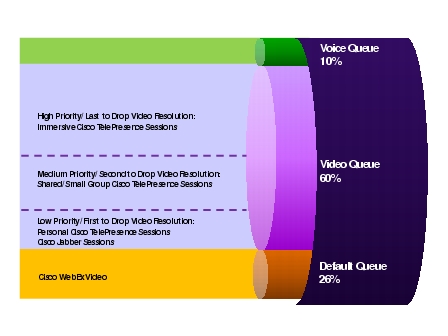
Cisco Network Bandwidth Allocation for Voice and Video Queues
The Cisco Precision Video Engine Codec, which is part of the Jabber client, also helps in detecting network congestion and reducing bandwidth use to avoid disrupting the user's audio and video experience.
Network Services
To use the Jabber video desktop sharing feature, each client endpoint must support Binary Floor Control Protocol (BFCP) and be administratively enabled on Cisco UCM. While a user is in an active Jabber softphone call, pressing the share desktop button will initiate an instant data share as part of the video stream. The Jabber client's desktop will be displayed on the far end video endpoint or bridge. BFCP is appealing because it is an open protocol that is based on SIP signaling and is compatible with videoconferencing devices.
Cisco technology provides network and platform services for all of the key functions in the Jabber clients. (Figure 4) For example, Cisco WebEx technology plays two roles in the Jabber clients:
- As the source for user presence information. WebEx uses a "presence from the cloud" model, which reflects the principles of reachability and open federation. Over time, Cisco IT expects presence to take an active role in establishing calls and negotiating their capabilities with other devices.
- For federating Jabber clients with other IM and presence systems. WebEx peering uses the industry-standard Extensible Messaging and Presence Protocol (XMPP).
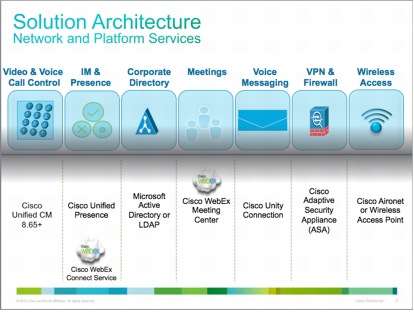
Figure 2. Cisco Technologies Used by Jabber Features
A Launch Program for Each Jabber Client
Because of differences in their underlying platforms today, each Jabber client has a unique set of features and user interface, although over time these differences will disappear. To handle the differences that exist today, Cisco IT created separate release programs for each Jabber client to simplify deployment and support processes.
Along with a staged deployment of the different clients, separate release programs helped Cisco IT transfer the knowledge and tools created in one program to others. Additionally, Cisco IT launched each client with a small group of pilot users to test deployment and support processes before making the client available to all employees.
Device Provisioning and Management
To automate provisioning of all Jabber clients on the company's Cisco UCM system, Cisco IT uses the following tools:
- Cisco Process Orchestrator: A platform for automating IT work flows
- Cisco Cloud Portal: A self-service portal for requesting network services such as downloading and provisioning a Jabber client
The Cisco IT user communication and support plan for the Jabber deployment included the following elements:
- A single community on the Cisco WebEx Social site for Jabber that allows users to obtain all information and self-support resources related to the Jabber clients.
- Document templates to present similar training and support information in a consistent way across the different clients so that related content would be familiar to users.
- Resources for user self-support including training videos, FAQ and task-specific instruction documents, and troubleshooting tools.
- Training for helpdesk employees to handle Jabber support issues that cannot be resolved by users.
- Coordination with IT staff in each world region to help ensure they understood the deployment plan and overall Jabber service.
Results
For Cisco as a company, the key benefit of Cisco Jabber is that the clients help more employees communicate more easily and efficiently wherever they are, on the device that is most convenient at that moment. Jabber support for SIP-based User Resource Identifier (URI) dialing allows users to make a call simply by clicking a phone icon, using either their laptop softphone or their associated hardware office phone. This feature receives a lot of praise from employees because they no longer have to look up or type in phone numbers to reach people. Instead, a voice and video conversation is a click away.
People can also set up a meeting or share desktop information in the same way. (Figure 3) "Cisco Jabber has made instant communication more instant," says Necole Jackson, Cisco IT service owner for Jabber and WebEx conferencing.
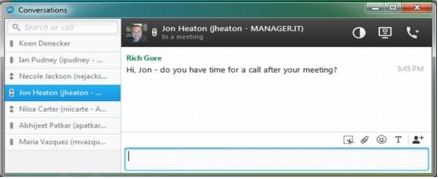
Figure 3. Starting a Voice or Video Call Means Just Clicking on the Phone Icon
With Cisco Jabber, placing and joining video calls is simple, which means more employees are gaining the communications clarity and relationship-building benefits of video. Cisco employees take advantage of the Jabber client's interoperability with Cisco video phones (9971 and 9951 models) and desktop and room-based Cisco TelePresence endpoints, and the ability to share their desktop for better information exchange and collaboration during a video call.
Cisco employees say that this convenience saves them time during the work day. Some of the first Cisco employees to use the Cisco Jabber client did so on the Advanced Cisco Experience (ACE) service introduction network. In a survey, these employees said that not having to look up a person's number, and knowing from their presence information or a quick IM chat whether they were available to take a call, saved them an average of 12 minutes per working day.
Many of the business applications frequently used by employees, such as the customer relationship management (CRM) system, can be accessed easily from a Jabber client. This program, called EasyApps@Work, offers employees significant time savings for handling routine tasks in their jobs.
Lessons Learned:
Cisco IT offers several recommendations for customers planning to deploy Cisco Jabber.
Implement a deployment program that is cross-functional. Determine the key stakeholders who will be needed to achieve a successful launch and promote user adoption of the Jabber clients. For example, a team with stakeholders from IT and individual business departments should be involved in developing the value case and strategy for deploying Cisco Jabber. When the launch begins, this team can also help with deployment and user adoption activities.
Configure adequate device capacity in the Cisco UCM clusters. Verify that the Cisco UCM clusters have the capacity needed to support a large number of Jabber clients, especially if employees install them on multiple devices. It may be necessary to upgrade the Cisco UCM clusters to version 8.5 or higher, or to add servers to the clusters.
Specify which Jabber clients will be supported. Determine which Jabber clients your IT department will support based on employee use of computer, smartphone, and tablet platforms. Perform lab testing of the Jabber clients with your Cisco UCM system and video endpoints to identify potential issues that may affect implementation plans. In addition, set expectations about feature parity and functionality for users who have multiple Jabber clients running on multiple devices.
Verify availability of adequate bandwidth. Bandwidth is especially important in local nodes to help ensure that users see acceptable performance in Jabber video calls. Load and stress testing in a lab environment can help to identify potential network performance issues under different use scenarios, such as when hundreds or thousands of users are in a single meeting room and try to use their Jabber clients at the same time.
Identify the different support needs of different user types. For example, some users may make more use of video calls, while others will be heavy users of the IM features. Information on actual use patterns can help in developing targeted materials for user and helpdesk training as well as user self-support resources. Data on actual usage also helps IT anticipate the support issues that may arise with new releases of the Jabber client software.
Prepare to support a product that you cannot completely control. It is important to recognize that IT cannot fully control which versions of the Jabber client are installed on phones and tablets because users can download the Jabber application directly from the Cisco website and the software automatically updates itself with new releases. Employees will also use the Jabber client at home or on VPN connections over the Internet, which means video performance may be lower than what they experience in the office. Information that sets appropriate user expectations for the client's performance can reduce confusion and support cases.
Next Steps
Cisco IT plans several enhancements to the Jabber service such as:
- Simplifying provisioning by using Cisco Prime Collaboration capabilities as an abstraction layer between the network components and the service provisioning stack.
- Enabling single sign-on to simplify user login and reduce support costs.
- Monitoring utilization of the video queue in local-office circuits and adjusting as needed to match actual video traffic patterns from both Cisco TelePresence endpoints and Jabber clients.
- Supporting Virtual Private LAN Service (VPLS). This service will allow Cisco users to connect with each other securely over the Internet without the additional step (and associated delay) of first going through the Cisco network.
Additionally, Cisco IT will continue to identify new use cases, business processes, and applications where Cisco Jabber can be integrated to help employees work more easily and productively.
Documentation:
Download the Introduced Cisco IT Jabber Datasheet (PDF).

